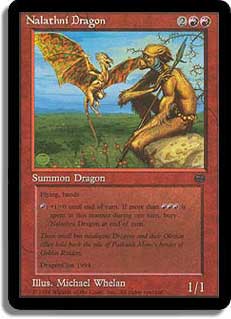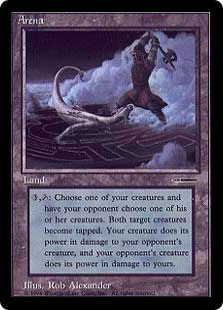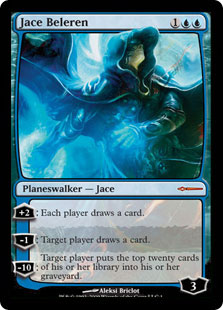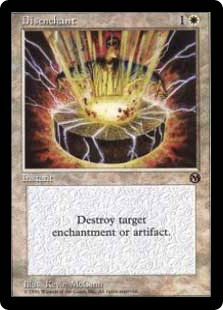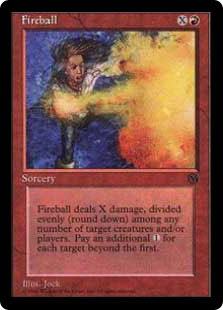Have you ever wondered where that weird foil or full art card came from? Do you know what the most valuable FNM card of all time is? Do the words ‘Arena League’ cause you to ruffle your brow in confusion? Have I got an article for you!
Before we get into that, though, I have a couple more Return to Ravnica points to address while they’re still somewhat timely.
The first is this card:
Ben Bleiweiss predicts an easy $10-$15 for this gal, and I’m inclined to agree. As of this writing, the card is up to $8 on StarCityGames.com, and I suspect it’ll already be over $10 by the time you read this. When it comes to Angels, never underestimate the casual crowd. Avacyn, Angel of Hope is outclassed by almost every other fatty in Standard, and it still retails for $12. Iona, Shield of Emeria has fallen out of favor in Legacy recently, and it’s still $15. The venerable Akroma, Angel of Wrath still sells for $10 despite multiple printings. In most games of casual or Commander play, I’d rather have Angel of Serenity than any of those—and there’s a very good shot this will see some tournament play as well. This is the only card in the set I have preordered a set of, and I feel supremely confident that they will hold their value.
The second point I’d like to bring up is that Return to Ravnica is a VERY high EV set. Even assuming every unknown rare/mythic is unplayable, there’s still a higher percentage of valuable cards in this set than any in recent memory.
In the short term, this means that cracking pack early is a winning proposition. Because product allocation will be limited, there won’t be enough Return to Ravnica to go around for the first month or two. It is possible that the average secondary market value of the card in the rare/mythic slot will be higher than the retail cost of a pack during this period. If you win prize packs at the Prerelease, feel free to bust them open and trade away the singles guilt-free.
Of course, that disparity can’t last long. Eventually, enough product will be printed to satisfy the market. If it makes financial sense for people to just crack boosters and sell cards, they’ll do just that until the singles come down to the point where it’s unprofitable to keep opening boosters. While the mythics could stay fairly high, most of the rares that are currently in the $5+ range should be coming down. In some cases, they’ll come very far down.
Of course, at a certain point sets go out of print and the average value of the rare slot no longer has to be less than the cost of a pack. Looking back at Magic’s history, there are many sets—Future Sight, Eventide, etc.—with a higher than average percentage of pricey rares.
In a vacuum, a ton of cards in this set should hold their value long term. At some point, putting money into depressed Return to Ravnica singles will make a lot of sense. That time just isn’t now.
With that out of the way, let’s talk about promos.
A Free Lunch
Promotional cards have existed almost as long as Magic itself. Unlike some other CCGs (Yu-Gi-Oh, I’m looking at you), Magic has resisted the allure of printing promotional cards that are pretty much required in order to play the best decks. You think Bonfire of the Damned is expensive now? Imagine what the price would be if it was a Grand Prix Top 8 exclusive.
In fact, one of the first promotional cards resulted in a bit of a PR nightmare. At Dragon*Con in 1994, Wizards handed out postcards to the first ten thousand guests that could be redeemed for a copy of a convention-excusive card called Nalathni Dragon.
This was the wild west days of CCGs, of course, so they didn’t really expect the obvious thing that came next: people who had copies of the card started charging a fortune for them, and everyone who wasn’t able to make the trek to Dragon*Con started raising a stink. In order to please the masses, Wizards took a page from kindergarten teachers everywhere and flooded the market. They gave out a copy with issues of Duelist Magazine issues #3 and #4, and even today the promo only retails for $2.
Nowadays, most promotional cards are either distributed widely (FNM foils) or are silly and fun enough to keep the demand low (Holiday cards). Reprints of cards with a high secondary market value are generally reserved for attendees of high-level events (Grand Prix foils) or provide compensation for members of the judge program. This latter strategy is particularly ingenious because it allows Wizards to provide a staff of part-time workers with fair compensation while paying them almost nothing. Â
Promo values come up a lot when trading and even more when buying collections. Having a good knowledge of promos prevents overpaying for cards that seem like they’d be worth a lot or missing out on unassuming cards that hold an unexpected amount value.
For example, which of the following cards do you think is worth more?
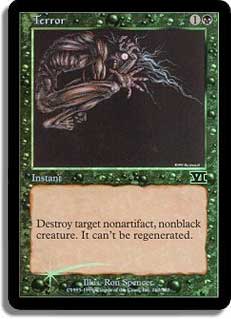
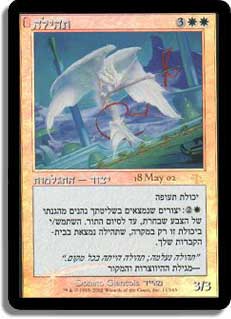
Got to be the Glory, right? It’s the only card ever to see print in Hebrew and is an amazing card in Commander to boot. That has to beat an aged removal spell whose time is past.
… Except that it isn’t true. The FNM Terror goes for $10, and the Hebrew Glory is worth a mere $3.
Knowledge is your number one ally at the trade tables, and I’m here to help give you a better understanding of the history of Magic promos. We can’t cover them all in a single week, so consider this part one of a multi-part series. Let’s start at the beginning.
Book Promos
In 1994, Magic released a set of ten tie-in novels that were put out by publishing house Harper Prism. The first five of them contained a page that could be sent in to Wizards in exchange for a special promotional card. The coupons from the first book got you a copy of Arena, at the time a card that was available nowhere else. The second book got you a Windseeker Centaur. The third was worth a Giant Badger. The fourth was Mana Crypt. The fifth was whatever they had left over. Until Arena was reprinted in Time Spiral and Mana Crypt was redone as a judge foil, this was the only place any of these cards was printed. You can tell a book promo by the expansion symbol, which is a small sideways pen.
Not only was Mana Crypt the only playable card in the bunch, it came out in the fourth book so it likely had the fewest number of redemptions. Mana Crypt sells for $80 today, while the other three are only worth between $1.50 and $2.
In 2009, Wizards released a novel called Agents of Artifice which told the story of famed planeswalker Jace Beleren. A small number of alternate-art Jace Belerens—one for each book in the initial order—were given to store owners who decided to stock the book AND who ran a Conflux Prerelease. This was back when regional Prereleases existed and many stores didn’t run their own. Most stores didn’t carry the book either. Because of how rare this card ended up being, this alternate-art Jace is currently worth a staggering $120.
Arena League Promos
Before the Friday Night Magic rebranding in 2006, the Arena League existed as its more casual, less cutthroat little brother. Designed to fill the void between casual and competitive Magic, the Arena League ran in game stores worldwide for about ten years.
The original idea behind the league was to keep track of matches over a given ‘season.’ At the end of each season, the best player in your store would receive an alternate art Disenchant. The second-best player got an alternate art Fireball. This was in the pre-foil era, and the promotion ran for about a year and a half.
The Disenchant goes for $2.50 now, while the Fireball is worth just $1.50. Neither card is very desirable, mostly because neither sees much play nowadays. These Arena promos are easy to tell apart because of their expansion symbol—a little ‘M’ with a circle around it.
In 1997, oversized and Vanguard cards were introduced to Arena League. I’ll be sure to cover these in detail when I do an article on oversized cards, but all of them hold at least a little bit of value as display pieces.
Foils were introduced to Magic in 1998, and the prize structure for Arena changed when they did. There was a different Arena foil each season, and you got one if you finished first or second in your shop or if you were chosen at random from the players in your store with over 30 ‘arena points.’ You got two points for winning a match and one for losing one, so we’re talking about a healthy amount of Magic for a shot at a single foil. Because of that, there were much fewer of these, comparatively, than FNM foils.
The first ten of these, all cards from Urza’s Saga and Sixth Edition, don’t have any specific markings identifying them as Arena foils. Since these sets had no normal foils, however, they are easy to tell apart.
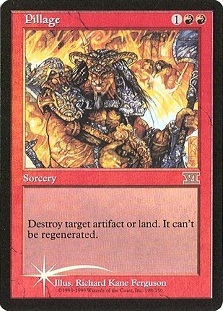
The next seven of them have the word ‘Arena’ printed where the expansion symbol should be. Otherwise, they are the same as normal foils. These are mostly older cards from Tempest and Mirage block.
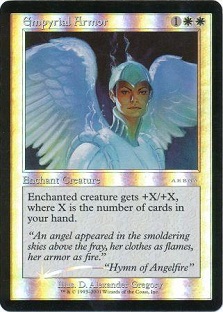
The next five all have a little gold ‘DCI’ logo where the expansion symbol should be.
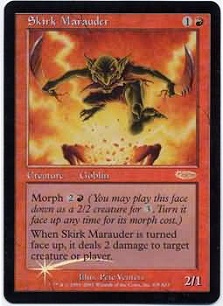
Standout foils from this era of the Arena League include the following:
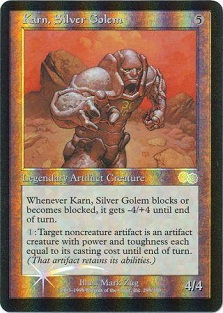
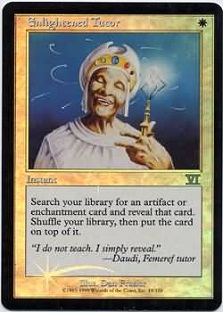
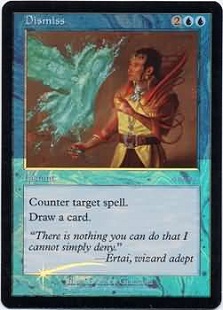
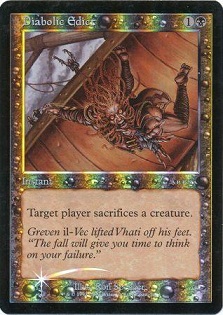
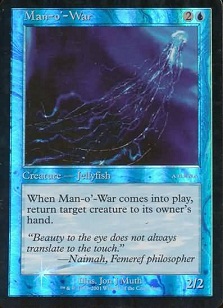
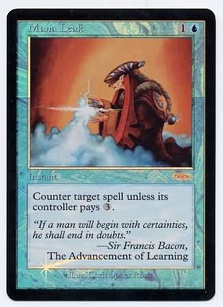
All of the above foils sell for $10 or more, and they’ve all got some room to grow still. Karn is the only one that isn’t a Cube staple, and he’s a popular commander. Enlightened Tutor is the most expensive of all the Arena foils, tipping the scales at $40.
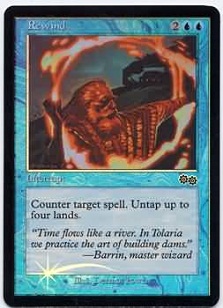
Looking for a sleeper? This version of Rewind is just $6, while the Arena Mana Leak is $20. If Rewind starts working its way into more Standard decks over the next year, expect this foil to nearly quadruple in value.
As the Arena League lumbered on, point totals, scoring, and prize allocation changed three more times over the next half-decade. The rules of this league were always sort of erratic, and in a lot of places the spirit of the thing was destroyed by people clamoring for foils and whining about points. It was finally put out of its misery at the end of the last Ravnica block, with most of the later foils being less desirable and much easier to earn. The Arena version of Coiling Oracle still sells for $4, but Wee Dragonauts, Okina Nightwatch, and the others from that era are barely worth a buck.
There were still a couple of decent Arena cards from this era, though:
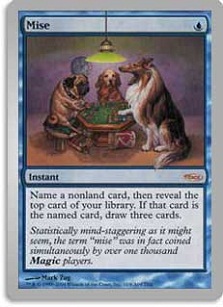
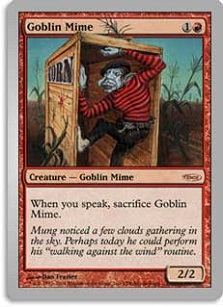
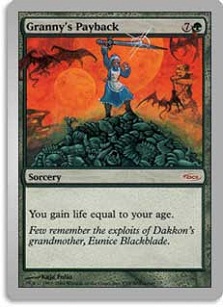
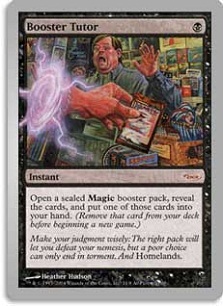
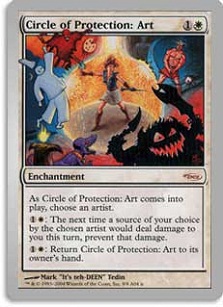
These alternate-art versions of Unhinged cards are still fairly desirable. The Circle of Protection and Goblin Mime are on the lower end at $6, and this version of Mise, featuring the poker-playing dogs, is the high point at $10. Note that these cards are not foil. They also gave out an alternate-art version of Ashnod’s Coupon from Unglued, which is foil, and that one goes for $5.
Holiday Cards
Since 2006, Wizards has given out one of these cards each December. They are staggeringly rare—most only go to Wizards employees, though some game stores receive a single copy as a ‘thank you’ gift from Hasbro.
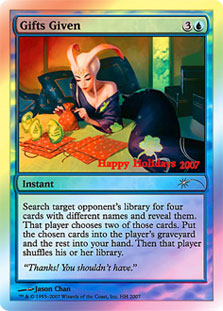
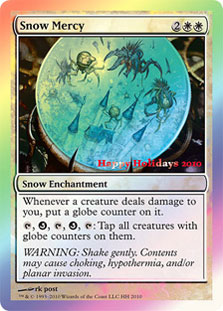
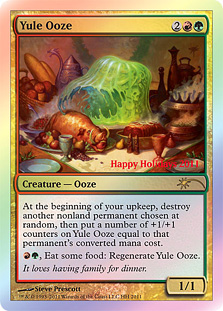
These vary in price based on how interesting the ability is and how well they perform in casual play. Gifts Given is easily the most powerful, and it’s also based on an iconic card. Because of that, it holds the highest price tag at $100. Yule Ooze is the cheapest at $60, mostly because it’s the most recent and therefore the easiest card to find.
All holiday cards have a shooting star expansion symbol and ‘Happy Holidays’ printed on the card.
Buy-a-Box Promos
Most people think of these as a recent thing, but the very first Buy-a-Box promo happened during Mercadian Masques. In May of 1997, Wizards opened an online store that allowed consumers to buy product directly from the company. If you bought a box of Masques at full retail, they sent you (while supplies lasted, of course) a copy of this card as well:
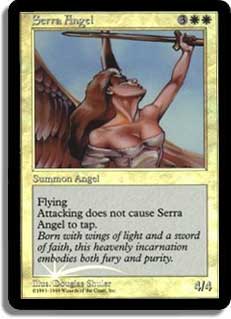
Even though Serra Angel is an uncommon now, this version is still worth $50. It’s the only foil copy of the card to feature the original, iconic art, and for many people Serra Angel is the single most resonant card in the entire game. I try to trade for these when I can, but most people who own them are unwilling to give them up.
The modern Buy-a-Box promotion started with the release of M10. The idea behind the promotion is that the first twenty people who buy a box from their local store are given a foil as a reward. For the most part, these foils have been fairly underwhelming and have ended up settling in the $4-$5 range.
Of course, there are a couple standouts:
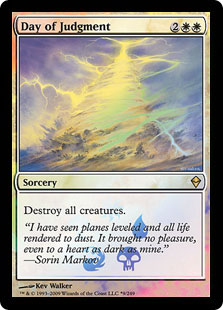
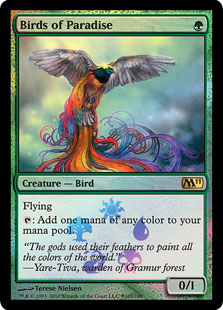
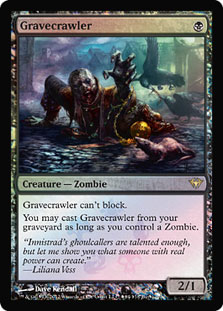
Of these, the Birds of Paradise is far and away the most expensive at $20. The art on this piece is outstanding, and even regular Birds of Paradise always trade well. I expect this version to keep slowly rising in price with no real ceiling. The Seventh Edition foil, remember, is up to $90.
I’m not sure quite why this version of Day of Judgment sells for $8. I suppose people like the art more than the Zendikar/M10/full art version.
This version of Gravecrawler doesn’t really hold much of a premium over the regular version, but the card is scorching hot in Standard right now.
All of these cards are watermarked—the Scars of Mirrodin era cards with their factions, and all others with five mana symbols in a pentagon. They all have their normal set expansion symbol and alternate art.
Pro Tour Foils
This set of promos lasted for just five years, from 2007 until last year when the Pro Tour became closed to the public. During that time period, visitors to the event could show up, talk to some of the Wizards employees, and get a free alternate-art foil to take home. You even got an extra foil at some of them for playing in side events. All of these cards are easily identifiable by the Pro Tour watermark.
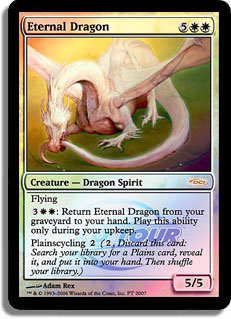
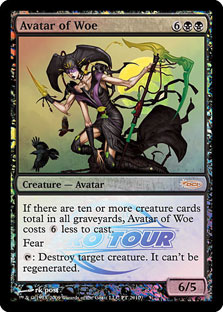
While Eternal Dragon is the oldest, Mirari’s Wake is the most expensive at $50 because it’s by far the most playable in casual Magic. Even a regular Mirari’s Wake from Judgment goes for $12 these days, and this foil is probably the single promotional card I am asked for the most. Eternal Dragon clocks in second at $30, while Treva, the Renewer and Avatar of Woe sell for $20 each. Ajani comes in at just $13, which makes sense considering there were more of these printed and they came out more recently. Over time, though, this will probably join the others in the $20-$30 range.
Grand Prix Foils
Also debuting in 2007, the Grand Prix foil program is still going strong. Due to the increase in Grand Prix and the public closing of the Pro Tour, there are now two Grand Prix foils released each year. The first half of 2012 gave us Goblin Guide, and the second half will include Therese Nielsen’s gorgeous Lotus Cobra.
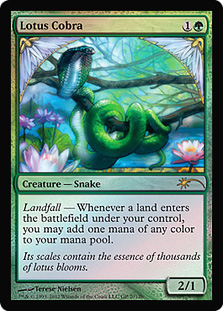
This card is only halfway through its run, having debuted at GP Atlanta on June 30th, and its $20 price tag dwarfs all the other GP promos save 2010’s $30 Umezawa’s Jitte. Even though the market will see quite a few more of these over the next few months, I expect the price to stay in the $15-$20 range simply due to how phenomenal the alternate art is on this card. It’s hard to get people to trade these away, even at GPs.
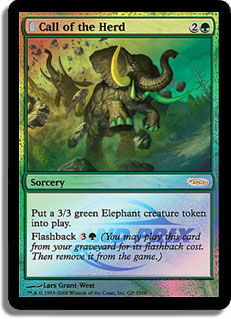
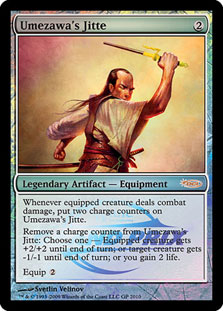
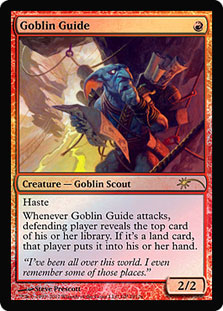
As for the others, I see the most growth potential for 2009’s Chrome Mox, currently a $15 card. If it ever starts to see more play in Legacy, look for these to quickly rise in value.
JSS Foils
The JSS ran for eight years from 1999 to 2006 and was a tournament series similar to the Grand Prix circuit. If you wanted to play in a JSS tournament, though, you had to be under sixteen and couldn’t have any Pro Tour experience.
At each event, they gave out a ‘participation foil’ to everyone who played as well as a separate ‘prize foil’ to the Top 8, the most sporting player, and the top finisher under twelve. The foils changed each year, much like the GP and PT promos. In 2006, the last year of the JSS, they did away with prize foils entirely and had two different participation cards.
Much like the Arena foils, the look of these changed often. The first year foils were both from Urza’s Saga and look just like set foils would. Prizes for the next two years have the gold ‘DCI’ expansion symbol instead of the set symbol. For the two years after that, ‘Super Series’ watermarks replaced the shiny comet in the lower right corner. For the final three years, the foiling process was changed to give the cards a distracting, ultra-shiny look.
Here are some of the prize cards:
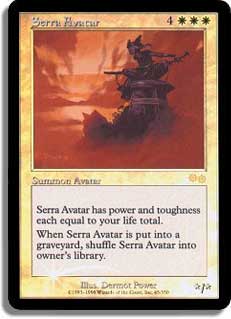
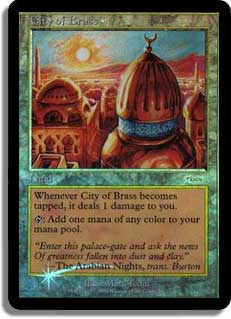
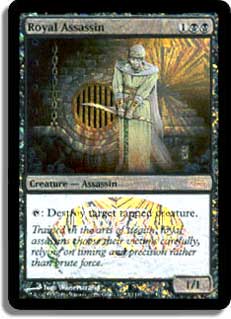
All of these are over $10 except for the Crusade, which is a mere $4. Why? In 2002, the Magic Player Rewards premium card was foil Wasteland. Due to the popularity of the card and some under-printing issues, they ran out halfway through the year. For the second half of 2002, Wasteland was replaced in those mailings by the JSS Crusade.
City of Brass is obviously the big winner here, and it looks stunning in person. This is arguably the nicest available version of this Cube staple, and it might be primed for another small bump in value.
Now for some of the participation cards:
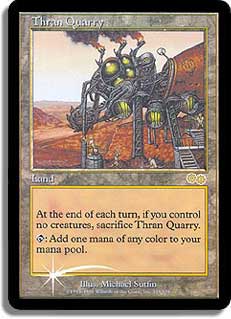
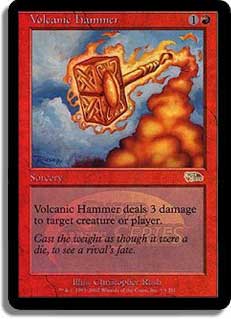
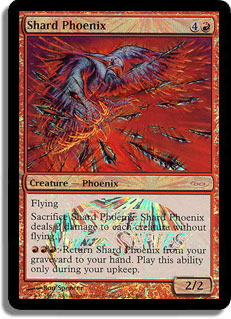
Lord of Atlantis is the best of these, but that card has been outclassed recently by Master of the Pearl Trident. Lord will still probably see some Legacy play, but I don’t expect it has much more room to grow. I’d give all of these a pass unless you’re trying for a complete collection.
Magic Scholarship Series Promos
In 2007, the JSS disbanded and was replaced by the Magic Scholarship Series. This was similar to the JSS, except the age limit was raised from 16 to 18 and the circuit was rebranded as a way for all high schoolers to use Magic to raise money for college.
Two promotional foils were released that year, still with the ‘brilliant’ foil sheen:
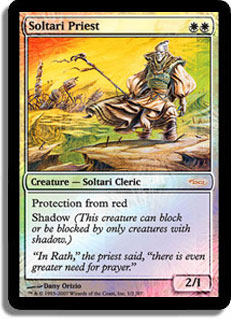
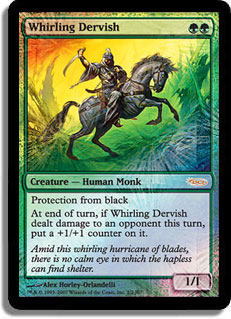
Neither card sees much play in any format, and this foiling process is supremely unpopular. Even though these foils are quite rare, the cards are only worth about $2.50 and are extremely hard to trade.
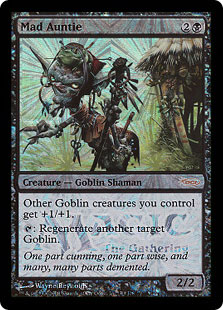
Three more cards were printed for the 2008 season: Glorious Anthem, Elvish Champion, and Mad Auntie. However, the MSS in the US and in Europe disbanded in the US before too many of these prizes could be awarded. They ran a little longer in Japan, and thus the Japanese promos are slightly more common.
The rarest of all are from the APAC region, where no MSS tournaments were run at all. As Magic collector Andy Horne told me:
“There was no 2008 Junior APAC Series. 14 [APAC promo Glorious Anthems] were given out at a Supa Nova convention to staff that did an exceptional job (some of whom weren’t Magic players)… A lot of collectors haven’t heard of the English ones, fewer still have heard of the APAC ones, and some collectors of the junior series cards don’t even realize there was an APAC junior series at all… I have heard of interns receiving the scholarship series ones in a reward pack they get when they finish working at WotC. One such person sold his soon after for $1000 USD.”
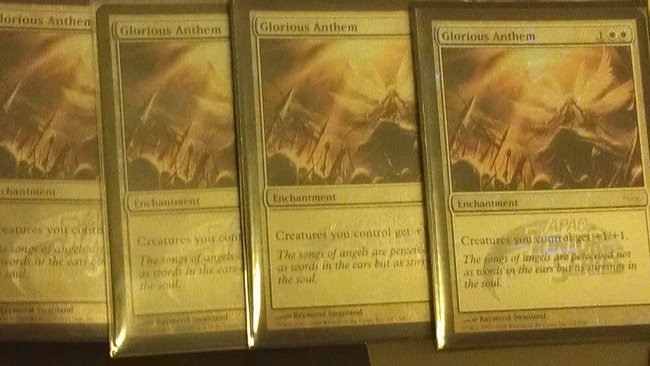
APAC versions of Glorious Anthem, as pictured above, are worth at least $1,000. You can tell that they are APAC because the watermark clearly identifies them as such. Even non-APAC versions of these cards command a ton of value, though. Star City lists a $30 retail value for the Mad Auntie, but the others two cards have alternate art and are worth even more. Japanese versions of the Glorious Anthem sell in the $120-$150 range, and a non-APAC English copy would likely retail around $200.
Join me next time when we cover FNM foils, Prerelease cards, and more!
–Chas Andres


